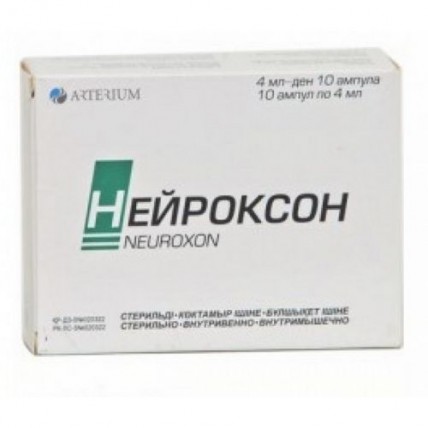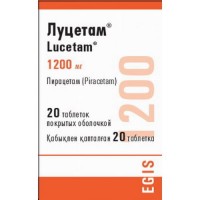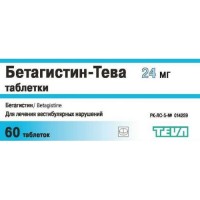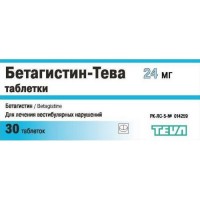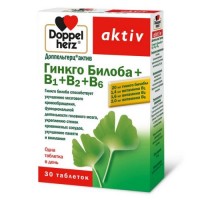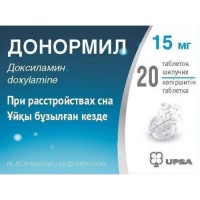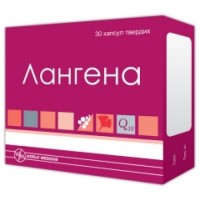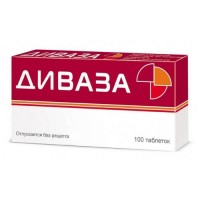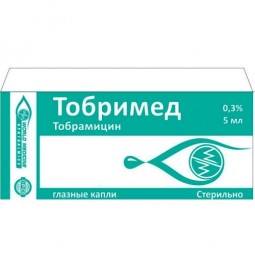Neyrokson 1000 mg / 4 ml 10s solution for injection in ampoules
- $72.40
NEYROKSON
the Trade name
Neurokson
Mezhdunarodnoye the unlicensed
name Tsitikolin (citicoline)
the Dosage form
Solution for injections of 500 mg / 4 ml, 1000 mg / 4 ml
Structure
1 ampoule of drug contains:
active agent – a tsitikolina of sodium (in terms of tsitikolin) – 522.5 mg or 1045.0 mg (500.0 mg or 1000.0 mg)
excipient – water for injections
the Description
Transparent colourless liquid
Pharmacotherapeutic group
of Psikhoanaleptiki. Psychostimulants and nootropa. Other psychogogic and nootropic means. Tsitikolin.
ATX N06B X06 code
Pharmacological
Pharmacokinetics properties.
Tsitikolin is well absorbed at intramuscular and intravenous administration. After administration of drug the substantial increase of level of sincalines in blood plasma is observed. At oral administration, drug is almost completely soaked up. Researches showed that bioavailability at oral and parenteral ways of introduction are almost identical.
Drug is metabolized in intestines and a liver with formation of sincaline and cytidine. After introduction tsitikolin it is acquired by brain tissues, at the same time sincalines affect phospholipids, cytidine - on cytidine nucleoids and nucleic acids. Tsitikolin quickly reaches tissues of a brain and is actively built in cell membranes, cytoplasm and mitochondrions, activating activity of phospholipids.
Only the insignificant quantity of the entered dose is removed with urine and a stake (less than 3%). About 12% of the entered dose are removed through airways. Removal of drug with urine and through airways has two phases: the first phase – fast removal (with urine – for the first 36 hours, through airways – for the first 15 hours), the second phase – slow release. The main part of a dose of drug is involved in metabolism processes.
Pharmacodynamics.
Tsitikolin stimulates biosynthesis of structural phospholipids in a membrane of neurons that promotes improvement of functions of membranes, including functioning of ion-exchange pumps and neuroceptors. Thanks to the stabilizing action on a membrane tsitikolin has antiedematous properties therefore reduces wet brain. Tsitikolin oppresses activity of some phospholipases, interferes with residual release of free radicals, prevents damage of membrane systems and provides preservation of a protective antioxidant system.
Tsitikolin reduces the volume of the damaged fabric, preventing death of cells, affecting apoptosis mechanisms, and improves cholinergic transfer. Tsitikolin also has preventive neurotyre-tread effect in focal strokes of a brain.
Tsitikolin promotes fast functional rehabilitation of patients in acute disorders of cerebral circulation, reducing ischemic defeat of tissues of brain that is confirmed by results of X-ray inspections.
In craniocereberal injuries tsitikolin reduces duration of the recovery period and reduces intensity of a posttraumatic syndrome.
Tsitikolin promotes increase in level of brain activity, reduces amnesia level, improves a state at cognitive, sensitive and motor disturbances which are observed in brain ischemia.
Indications
- a sharp phase of disturbances of cerebral circulation and treatment of complications and consequences of disturbances of cerebral circulation.
- craniocereberal injury and its consequences.
- the neurologic disorders (cognitive, sensitive, motor) caused by cerebral pathology of degenerative and vascular genesis.
A route of administration and doses
For intravenous or intramuscular administration.
The recommended dose for adults makes from 500 mg to 2000 mg a day.
The first 2 weeks on 500-1000 mg 2 times a day intravenously, then – on 500-1000 mg 2 times a day intramusculary. The maximum daily dose – 2000 mg.
At acute and medical emergencies the maximum therapeutic effect is reached when prescribing drug in the first 24 hours.
In case of need treatment is continued by drug Neurokson, solution for oral administration. The recommended course of treatment at which the maximum therapeutic effect is observed makes 12 weeks.
Doses of drug and terms of treatment depend on weight of damage of a brain and are established by the doctor individually.
Intravenously appoint in the form of a slow intravenous injection (for 3-5 minutes, depending on the entered dose) or drop intravenous injection (40-60 drops a minute). Patients of advanced age of dose adjustment do not demand.
Side effects
Side reactions arise very seldom (& lt, 1/10000), including isolated cases.
- nausea, vomiting, diarrhea
- arterial hypertension, arterial hypotension, tachycardia
- a severe headache, dizziness, feeling of heat, a tremor
- hallucinations, excitement
- dispnoe
- a fever, hypostasis, allergic reactions, including: rash, a purpura, urticaria, an itching, angionevrogichesky hypostasis, an acute anaphylaxis, fervescence, the increased perspiration, changes in the injection site, erubescences up to purple coloring.
Contraindications
- hypersensitivity to drug components.
- the raised tone of parasympathetic nervous system.
Medicinal interactions
Tsitikolin enhances effect of a levodopa. It is not necessary to appoint along with the medicines containing Meclofenoxatum.
Special instructions
in case of permanent intracraneal hemorrhage it is not necessary to exceed a dose of 1000 mg a day and speed of intravenous administration of 30 drops a minute.
Drug is used right after opening of an ampoule. The ampoule with drug is intended only for single use. Residues of drug need to be destroyed.
Use during pregnancy and a lactation.
There are not enough data on Neurokson's use to pregnant women. Data on excretion of a tsitikolin in breast milk and its action on a fruit are not known. Therefore during pregnancy or feeding a breast drug is appointed only when the expected advantage for mother exceeds potential risk for a fruit.
Use in pediatrics
is Not enough data on Neurokson's use to children. Drug is used in urgent cases when the expected advantage of use exceeds potential risk.
Features of influence of medicine on ability to run the vehicle or potentially dangerous mechanisms
In some cases some side reactions from the central nervous system can affect ability to run motor transport and to work with difficult mechanisms.
Overdose
Cases of overdose are not described.
In case of emergence, symptoms of overdose are shown by strengthening of side effect of drug.
Treatment: symptomatic.
A form of release and packing
On 4 ml of drug (500 mg / 4 ml) in ampoules from neutral glass with a capacity of 5 ml with a ring either with a point of a break or on 4 ml of drug (1000 mg / 4мл) in ampoules from neutral glass with a capacity of 5 ml with a ring of a break of red color (Panton 186C).
On 5 ampoules put in blister strip packaging or on 5 ampoules put in the blister strip packaging covered with a film.
On 2 blister strip packagings together with the instruction for medical use in the state and Russian languages put in a pack.
To Store storage conditions in original packing, at a temperature not above 30 °C.
To store out of children's reach!
A period of storage
2 years
not to apply after an expiration date
Prescription status
According to the prescription.
JSC Galichpharm producer, Ukraine
the Trade name
Neurokson
Mezhdunarodnoye the unlicensed
name Tsitikolin (citicoline)
the Dosage form
Solution for injections of 500 mg / 4 ml, 1000 mg / 4 ml
Structure
1 ampoule of drug contains:
active agent – a tsitikolina of sodium (in terms of tsitikolin) – 522.5 mg or 1045.0 mg (500.0 mg or 1000.0 mg)
excipient – water for injections
the Description
Transparent colourless liquid
Pharmacotherapeutic group
of Psikhoanaleptiki. Psychostimulants and nootropa. Other psychogogic and nootropic means. Tsitikolin.
ATX N06B X06 code
Pharmacological
Pharmacokinetics properties.
Tsitikolin is well absorbed at intramuscular and intravenous administration. After administration of drug the substantial increase of level of sincalines in blood plasma is observed. At oral administration, drug is almost completely soaked up. Researches showed that bioavailability at oral and parenteral ways of introduction are almost identical.
Drug is metabolized in intestines and a liver with formation of sincaline and cytidine. After introduction tsitikolin it is acquired by brain tissues, at the same time sincalines affect phospholipids, cytidine - on cytidine nucleoids and nucleic acids. Tsitikolin quickly reaches tissues of a brain and is actively built in cell membranes, cytoplasm and mitochondrions, activating activity of phospholipids.
Only the insignificant quantity of the entered dose is removed with urine and a stake (less than 3%). About 12% of the entered dose are removed through airways. Removal of drug with urine and through airways has two phases: the first phase – fast removal (with urine – for the first 36 hours, through airways – for the first 15 hours), the second phase – slow release. The main part of a dose of drug is involved in metabolism processes.
Pharmacodynamics.
Tsitikolin stimulates biosynthesis of structural phospholipids in a membrane of neurons that promotes improvement of functions of membranes, including functioning of ion-exchange pumps and neuroceptors. Thanks to the stabilizing action on a membrane tsitikolin has antiedematous properties therefore reduces wet brain. Tsitikolin oppresses activity of some phospholipases, interferes with residual release of free radicals, prevents damage of membrane systems and provides preservation of a protective antioxidant system.
Tsitikolin reduces the volume of the damaged fabric, preventing death of cells, affecting apoptosis mechanisms, and improves cholinergic transfer. Tsitikolin also has preventive neurotyre-tread effect in focal strokes of a brain.
Tsitikolin promotes fast functional rehabilitation of patients in acute disorders of cerebral circulation, reducing ischemic defeat of tissues of brain that is confirmed by results of X-ray inspections.
In craniocereberal injuries tsitikolin reduces duration of the recovery period and reduces intensity of a posttraumatic syndrome.
Tsitikolin promotes increase in level of brain activity, reduces amnesia level, improves a state at cognitive, sensitive and motor disturbances which are observed in brain ischemia.
Indications
- a sharp phase of disturbances of cerebral circulation and treatment of complications and consequences of disturbances of cerebral circulation.
- craniocereberal injury and its consequences.
- the neurologic disorders (cognitive, sensitive, motor) caused by cerebral pathology of degenerative and vascular genesis.
A route of administration and doses
For intravenous or intramuscular administration.
The recommended dose for adults makes from 500 mg to 2000 mg a day.
The first 2 weeks on 500-1000 mg 2 times a day intravenously, then – on 500-1000 mg 2 times a day intramusculary. The maximum daily dose – 2000 mg.
At acute and medical emergencies the maximum therapeutic effect is reached when prescribing drug in the first 24 hours.
In case of need treatment is continued by drug Neurokson, solution for oral administration. The recommended course of treatment at which the maximum therapeutic effect is observed makes 12 weeks.
Doses of drug and terms of treatment depend on weight of damage of a brain and are established by the doctor individually.
Intravenously appoint in the form of a slow intravenous injection (for 3-5 minutes, depending on the entered dose) or drop intravenous injection (40-60 drops a minute). Patients of advanced age of dose adjustment do not demand.
Side effects
Side reactions arise very seldom (& lt, 1/10000), including isolated cases.
- nausea, vomiting, diarrhea
- arterial hypertension, arterial hypotension, tachycardia
- a severe headache, dizziness, feeling of heat, a tremor
- hallucinations, excitement
- dispnoe
- a fever, hypostasis, allergic reactions, including: rash, a purpura, urticaria, an itching, angionevrogichesky hypostasis, an acute anaphylaxis, fervescence, the increased perspiration, changes in the injection site, erubescences up to purple coloring.
Contraindications
- hypersensitivity to drug components.
- the raised tone of parasympathetic nervous system.
Medicinal interactions
Tsitikolin enhances effect of a levodopa. It is not necessary to appoint along with the medicines containing Meclofenoxatum.
Special instructions
in case of permanent intracraneal hemorrhage it is not necessary to exceed a dose of 1000 mg a day and speed of intravenous administration of 30 drops a minute.
Drug is used right after opening of an ampoule. The ampoule with drug is intended only for single use. Residues of drug need to be destroyed.
Use during pregnancy and a lactation.
There are not enough data on Neurokson's use to pregnant women. Data on excretion of a tsitikolin in breast milk and its action on a fruit are not known. Therefore during pregnancy or feeding a breast drug is appointed only when the expected advantage for mother exceeds potential risk for a fruit.
Use in pediatrics
is Not enough data on Neurokson's use to children. Drug is used in urgent cases when the expected advantage of use exceeds potential risk.
Features of influence of medicine on ability to run the vehicle or potentially dangerous mechanisms
In some cases some side reactions from the central nervous system can affect ability to run motor transport and to work with difficult mechanisms.
Overdose
Cases of overdose are not described.
In case of emergence, symptoms of overdose are shown by strengthening of side effect of drug.
Treatment: symptomatic.
A form of release and packing
On 4 ml of drug (500 mg / 4 ml) in ampoules from neutral glass with a capacity of 5 ml with a ring either with a point of a break or on 4 ml of drug (1000 mg / 4мл) in ampoules from neutral glass with a capacity of 5 ml with a ring of a break of red color (Panton 186C).
On 5 ampoules put in blister strip packaging or on 5 ampoules put in the blister strip packaging covered with a film.
On 2 blister strip packagings together with the instruction for medical use in the state and Russian languages put in a pack.
To Store storage conditions in original packing, at a temperature not above 30 °C.
To store out of children's reach!
A period of storage
2 years
not to apply after an expiration date
Prescription status
According to the prescription.
JSC Galichpharm producer, Ukraine
